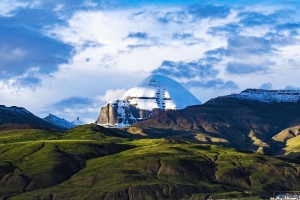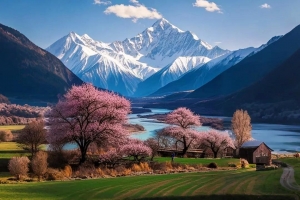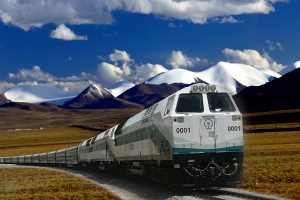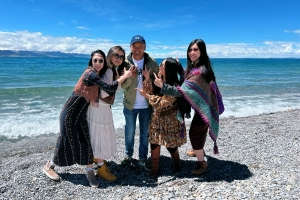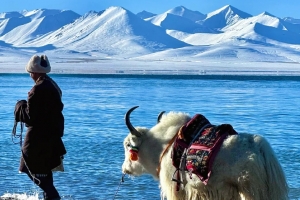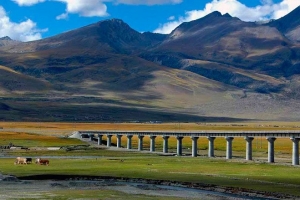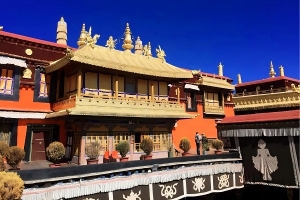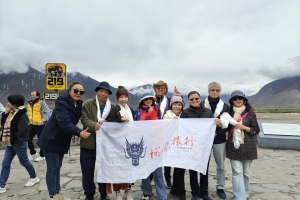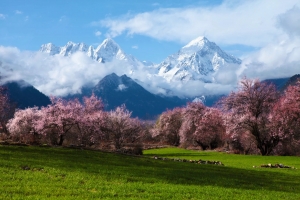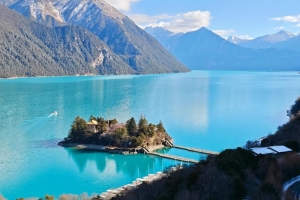Kora – often translated as circumambulation – is one of the most visible and deeply felt practices you will encounter while traveling through Tibet, the Tibetan Plateau, and Tibetan Buddhist communities across the Himalaya. For visitors, the sight of steady lines of pilgrims circling a holy mountain, temple, or stupa can be at once puzzling and profoundly moving. This guide explains what kora is, why people do it, where it is performed, how it is carried out (from walking meditation to full prostration), and how international travelers can approach the practice with respect and mindfulness.
What Is Kora (Circumambulation)?
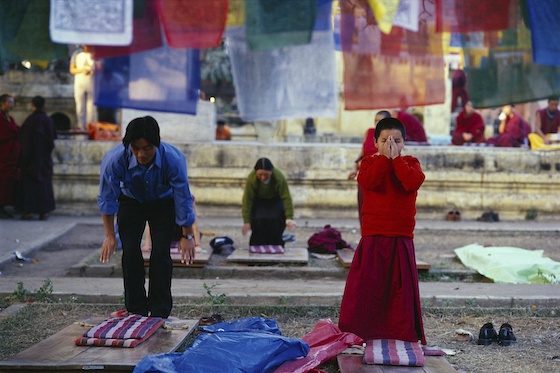
Etymology And Meaning
The English word circumambulation comes from Latin roots: circum meaning “around” and ambulare meaning “to walk.” In Tibetan, the practice is called kora (བསྐོར་བ།) — literally “to walk around.” Another commonly used Tibetan term is nékor (གནས་སྐོར), which emphasizes the act of circling an né — an abode, dwelling, or markedly sacred place. In short, kora means intentionally walking around something regarded as holy, with the intention of prayer, purification, or spiritual gain.
Kora As Devotional Practice
Kora is far more than a physical act of walking. For Tibetan Buddhists it is a devotional practice, a walking meditation and a pilgrim’s discipline. People perform kora to accumulate merit, purify past negative actions, cultivate compassion and bodhicitta (an awakened mind), or seek blessings. Kora can be done alone or in groups, slowly or quickly, quietly or while chanting — but it is always an outward expression of faith and an inward practice of attention.
Why Do People Perform Kora?
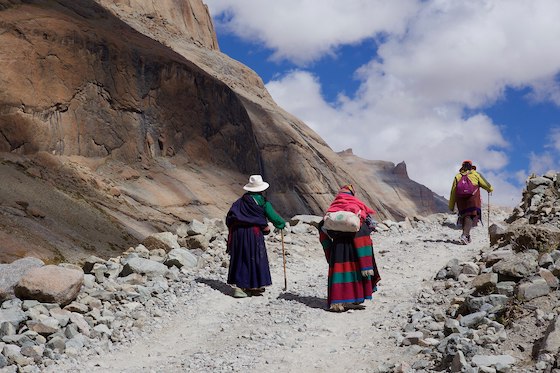
Merit, Transformation, And Intention
In Tibetan Buddhism, the sacredness of a place or object is believed to have the power to transform those who approach it with sincere intention. The more powerful the né, the greater the potential spiritual benefit. Pilgrims believe that by circling a sacred mountain, shrine, or image — especially in prescribed numbers of circuits — they accumulate merit, change habits of mind, and move closer to awakening.
Meditation, Devotion, And Community
Kora is a form of walking meditation: the repetitive motion of placing one foot in front of the other helps steady the mind. Many pilgrims chant mantras, spin prayer wheels, or count mala beads as they walk, adding layers of focused practice to the physical movement. Kora also fosters community: shared routes and rhythms knit together strangers, monastics, and whole towns in a living web of devotion.
Where Are The Sacred Places For Kora?
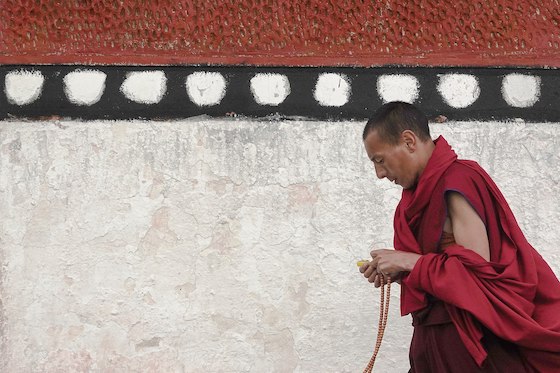
Sacred Natural Places
Some of the most powerful né are not built by human hands but are natural features recognized as sacred. The best-known example is Mount Kailash (Gang Rinpoche, “precious jewel of snows”), considered supremely sacred by Tibetan Buddhists, Hindus, Jains, and Bön practitioners. Circumambulating Mount Kailash on foot — a demanding pilgrimage of roughly 52 kilometers — is believed to bring profound merit and spiritual benefit.
Other sacred natural sites include high plateau lakes such as Manasarovar, Yamdrok, and Namtso. These lakes are revered for their purity and spiritual power; many pilgrims perform kora along their shores as part of a larger pilgrimage circuit.
Human-Made Places
Kora is equally central to human-made sacred spaces. Stupas, monasteries, temples, and hermitages are encircled by pilgrims on any given day. Famous examples include the Jokhang Temple and the Potala Palace in Lhasa, both of which attract steady flows of pilgrims who walk the Barkhor circumambulatory street around the Jokhang. Beyond Tibet, visitors in Nepal will often see kora performed around stupas like Boudhanath and Swayambhunath.
A Holy Person As Né
A living holy person can be a focal point for circumambulation too. Pilgrims sometimes circle the compounds of important teachers or spiritual leaders — for example, routes exist around the Dalai Lama’s compound and Namgyal Monastery in Dharamsala. The act of walking around an embodied holy presence acknowledges their spiritual authority and seeks blessings.
How Is Kora Performed?
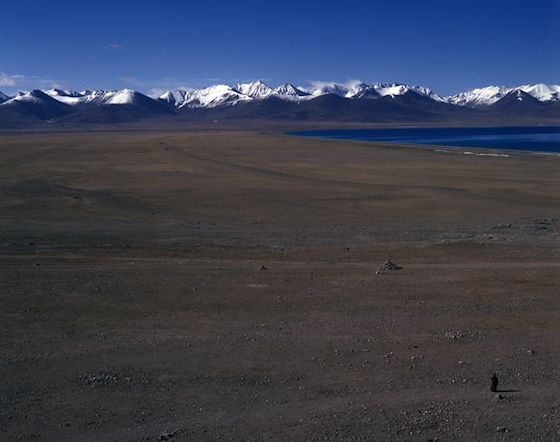
Direction And Variations
In Tibetan Buddhist practice the standard direction for kora is clockwise, which aligns with the imagined path of enlightened activity. By contrast, followers of the Bön tradition commonly circumambulate counterclockwise. These directional choices are meaningful and should guide visitors: watch first, follow the flow, and avoid cutting across the path of pilgrims.
Kora varies in scale and intensity. Some people do a short, gentle circuit around a local stupa or monastery as part of a visit. Others undertake grueling multi-day circuits, such as the Mount Kailash kora, which is a serious undertaking that often includes high passes, cold nights, and deep commitment.
Mantras, Prayer Wheels, And Mala Beads
Kora is commonly accompanied by devotional tools. Pilgrims frequently recite mantras — short sacred phrases repeated aloud or silently. The mantra “Om Mani Padme Hum” is widely heard, and many pilgrims keep mala bead counters to track mantra recitations. Prayer wheels, which contain rolled texts of sacred prayers, are spun by the hundreds in pilgrimage circuits. Each clockwise rotation is considered equivalent to reciting the prayers inside.
Prostrations: The Extreme Kora
One of the most intense forms of kora combines circumambulation with repeated full-body prostrations. A pilgrim performing prostration-kora stretches out flat on the ground, marks the spot reached by their fingertips or a token, stands, steps forward to that spot, and prostrates again. This process may continue for the entire circuit or for long sections of it. Prostration-kora is a powerful method of purification and devotion; it requires tremendous physical stamina and humility. To protect themselves from the rough ground, practitioners may wear leather aprons, knee pads, gloves, or attach wooden planks to their hands.
Kora In Monasteries And Nunneries
Monasteries and nunneries are designed with kora in mind. Many have purpose-built circumambulatory paths that allow monastics to walk their practice, take daily healthy exercise, and engage in devotion. For residents, kora is woven into the rhythm of monastic life: walked after morning prayers, during festival days, and as part of solitary practice. Visitors will often see monks and nuns maintaining steady, meditative steps around their sacred compounds.
Practical Tips For Travelers
Etiquette And Respect
If you encounter kora while traveling, follow these simple rules of etiquette:
- Observe first. Watch how locals perform kora before joining; patterns vary by place and tradition.
- Go with the flow. Walk in the same direction as pilgrims and avoid stepping across circumambulatory paths.
- Keep a low profile. Avoid loud conversations or abrupt movements; maintain a respectful distance from those deep in practice.
- Ask before photographing. Many pilgrims are comfortable with photos, but some are not; always ask permission when photographing individuals, especially during prostrations or intimate moments of devotion.
- Avoid commercializing sacred acts. Don’t stage photos or performances of kora for social media that might feel exploitative.
What To Wear And Bring
Dress modestly and practically. Long sleeves, long trousers or skirts, and covered shoulders are generally appropriate around religious sites. Comfortable walking shoes are a must; if you plan to join a longer kora, consider sturdy hiking boots. If you find pilgrims wearing protective clothing for prostration, that’s often because the ground is rough — consider gloves or knee pads if you intend to make prolonged physical offerings.
Bring water, snacks, sun protection, and a small personal first-aid kit. If you plan to spin prayer wheels or recite mantras, a small mala or prayer beads can be helpful.
Physical Preparation And Altitude
Many kora routes, particularly those around high lakes and mountains like Mount Kailash, sit at high elevations and can challenge even fit travelers. Allow time for acclimatization, travel with a knowledgeable guide, and be aware of symptoms of altitude sickness. For strenuous circumambulations, physical training before departure—cardio conditioning and leg-strengthening—will make the journey more enjoyable and safer.
Photography And Interaction
Photography can capture the awe of kora, but always prioritize dignity. Avoid photographing people in obvious distress or during private devotional acts. Offerings such as flowers, incense, or butter lamps are common — if you wish to contribute, ask a local or a monastery attendant how to do so properly.
Kora Routes Worth Planning Around
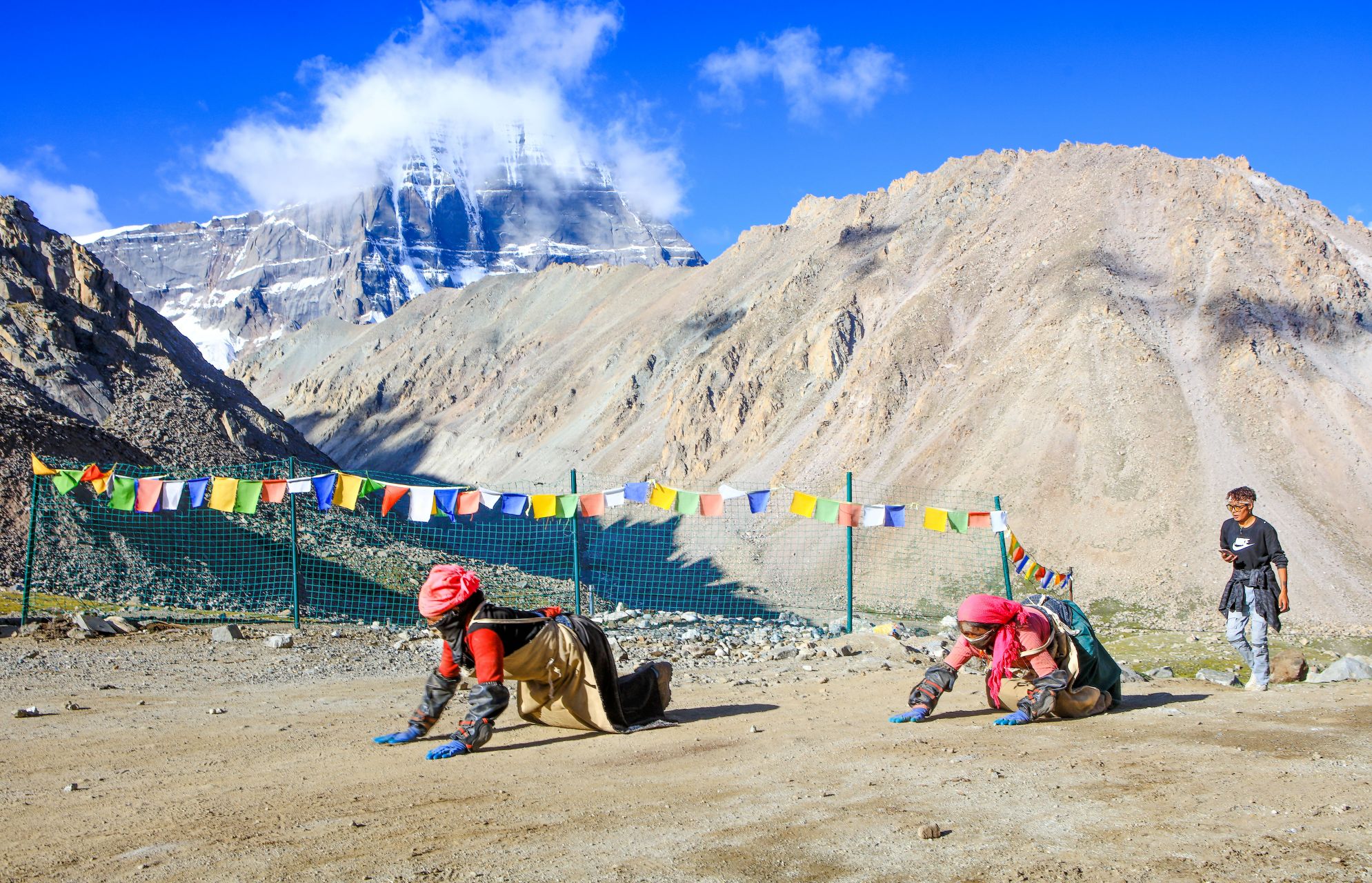
For travelers who want to witness or participate in kora, a few routes are especially rewarding:
- Jokhang Barkhor (Lhasa): A bustling, living circumambulatory street where pilgrims, vendors, and locals converge. It’s accessible for visitors and a rich introduction to Tibetan urban kora.
- Potala Palace precincts (Lhasa): Walking the outer pathways of the Potala gives insight into royal and religious history and the steady devotion of local pilgrims.
- Mount Kailash kora (Ngari/Ali): The most famous high-mountain kora, a physically demanding multi-day circuit that attracts international pilgrims seeking deep spiritual transformation.
- Namtso, Yamdrok, Manasarovar: Lakeshores where local circuits and lakeside prostrations are woven into pilgrimage itineraries.
- Boudhanath and Swayambhunath (Kathmandu Valley): If your travels pass through Nepal, these giant stupas offer accessible and photogenic kora experiences.
When planning, consult experienced local guides who understand seasonal weather, permits, and proper routes. Some circuits require permits, organized transport, and highlands logistics.
Kora’s Role In Daily Life And Community
Beyond pilgrimage, kora is a social and cultural practice that knits communities together. Festivals, market days, and religious observances often center on circumambulatory routes. For many Tibetans, daily kora around a local stupa or temple is a way of life: the practice marks time, connects neighbors, and provides physical and mental balance. For visitors, witnessing this rhythm offers rare access to spiritual life grounded in place.
Experiencing Kora: A Traveler’s Mindset
Kora is both simple and profound. At face value it is walking in a circle; at depth it is a portable temple, a moving altar, and a communal practice that binds pilgrims to place, to one another, and to inner transformation. For international travelers, encountering kora can be one of the most memorable and humbling experiences of a trip to Tibet and the Himalayan cultural zone. With respect, preparation, and an open heart, witnessing or taking part in circumambulation can add a powerful dimension to your travels.
Ready To Experience Kora?
If you are planning a trip and want to experience kora with knowledgeable local guidance, Journey2tibet offers custom itineraries, experienced guides, and responsible cultural introductions to help you engage respectfully with these sacred practices. Whether you want a short kora in Lhasa or a guided pilgrimage to Mount Kailash, Journey2tibet can tailor a route to your interests, fitness level, and travel dates—so you can encounter kora in a meaningful, safe, and culturally sensitive way.
Best Tibet Kora Tour: 15 Day Mount Kailash Group Tour

